7th Chords on Piano - The Dominant Chord
Home » Piano Chords » 7th Chords on Piano - The Dominant Chord
The story of seventh chords is pretty easy. You take a chord (Whether it's a major or a minor chord) in the root position and you add a minor third on top of it.
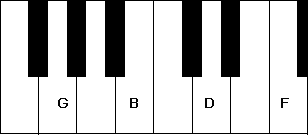
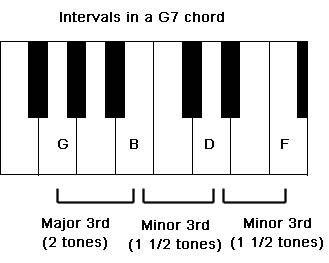
So if you have a G major chord, all you have to do in order to transform it to a seventh chord is adding the note F on top of it. You'll end up with the note G, B, D and F which you can play with the 1st, 2nd, 3rd and 5th fingers of the right hand.
That's how we create a 7th chord in the root position.
A 7th chord is stated by the following chord symbol. You'll see the letter that stated the key note of the chord and the number seven right after it. A G 7th chord for example will be written as G7.
Here's a handy chord chart of all major 7th piano chords in the root position.
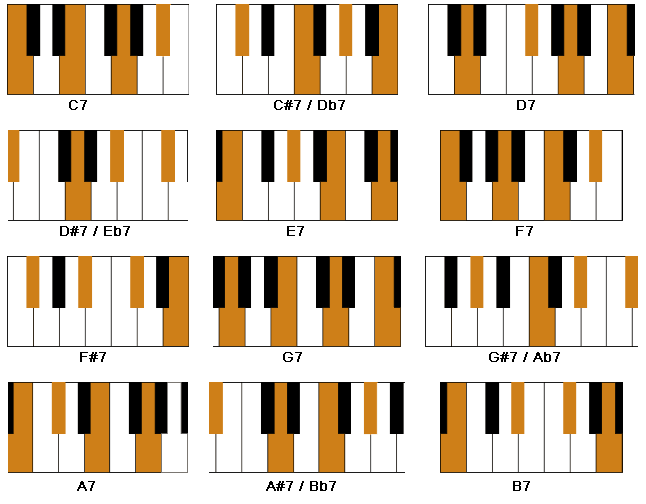
Chord Inversions of 7th Piano Chords
Until today we dealt with chord with 3 notes - triads. 7th chord have an extra note and so naturally four note chords will have an extra chord inversion.
Let's take G7 for example:
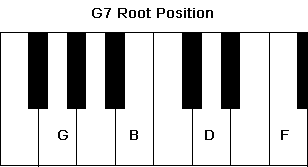
We start with the root position and we add a minor third on top of D (the last note of G major). We end up with the notes G, B, D and F played with the 1st, 2nd, 3rd and 5th fingers of the right hand. All major and minor 7th piano chords should be created at the same manner.
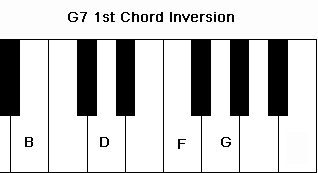
In order to move to the 1st chord inversion we replace the G note above the other notes and we get the notes in this order: B, D, F and G played with the 1st, 2nd, 4th and 5th fingers of the right hand.
This is the only chord inversion where we're going to replace the 3rd finger with the 4th finger.
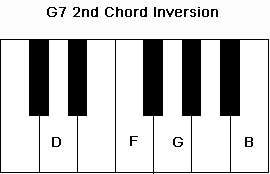
Up next, the 2nd inversion; We'll lift the B note above D, F and G and end up with the note D,F,G and B played with the 1st, 2nd, 3rd and 5th fingers.
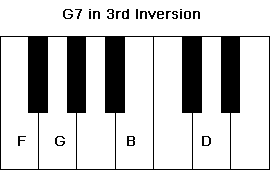
Here's the extra chord inversion - the 3rd one. By replacing the D note above F, G and B we'll play the notes F,G,B and D with the 1st, 2nd, 3rd and 5th fingers again.
Now G is the key note of the chord right? F is the extra note we added (The 7th note). Pay attention that the 7th note is placed a whole tone under the key note. That's another useful way to find seventh chords easily and quickly.
By replacing the F note (the 7th note) above G,B and D we return to G7 in the root position again.
Seventh Chords as Dominant Chords
Now that we know how to created seventh chords let's try to understand how they function in music or in other words what they're for.
Music is built out of the simple element of tension and release. That's something we all react to. Without getting too much into piano chord theory I can tell you that chords are related to each other according to how much tension or release they create towards the next chord.
Basically in every piece in western music (Accept from the really modern ones) there are two important chords: The home chord which provides the full harmonic rest and the dominant chord which contains so much tension that you have to go straightto the home chord.
Seventh chords are these DOMINANT CHORDS. They create a lot of tension and they always push you to back to a home chord so when you see a G7 for example you should suspect it's a dominant chord and that you're about to fulfil the tension in this chord in the next chord which is going to be its relative home chord. Maybe now you'll find it easier to recognize 7th chord by ear. You just have to catch the tension of the chord in you're ear and hear how it is leading to the home chord.
7th Chords as Blues Chords
The blues was famous for breaking lots of rules. The blues uses 7th piano chords differently. Instead of using them as tension chords that lead home it uses the 7th chord often just as an impression.
In other words 7th chords are played in blues to create a bluesy sound instead of leading somewhere. 7th chords are often used in this manner also in late classical pieces by Debussy for example.
To sum up this issue: Today we've learned how to form 7th chords in all chord inversions. Later on when we focus on piano chord theory we're going to get to know how these chords function in a musical context in details.
 People want to learn how to play chords in order to be able to play any song they desire easily.
Some find it easy to learn how to form new chords but don't know how to take the next step to
combine them in a song, moving smoothly from one chord to the other while playing the rhythm at the same time
People want to learn how to play chords in order to be able to play any song they desire easily.
Some find it easy to learn how to form new chords but don't know how to take the next step to
combine them in a song, moving smoothly from one chord to the other while playing the rhythm at the same time
Some like to imitate what they see on a video but you can learn how to form all possible amazing piano chords and learn to play an enormous amount of different rhythms while playing popular songs by artists like the Beatles, Adele, Bruno Mars, Leonard Cohen and more.
Check out our complete "Piano by chords" course where you'll go through a journey that combines both piano lessons and piano tutorials the will make play the piano like a PRO!
Click here to check out the Piano by Chords Learning Kit Now!














